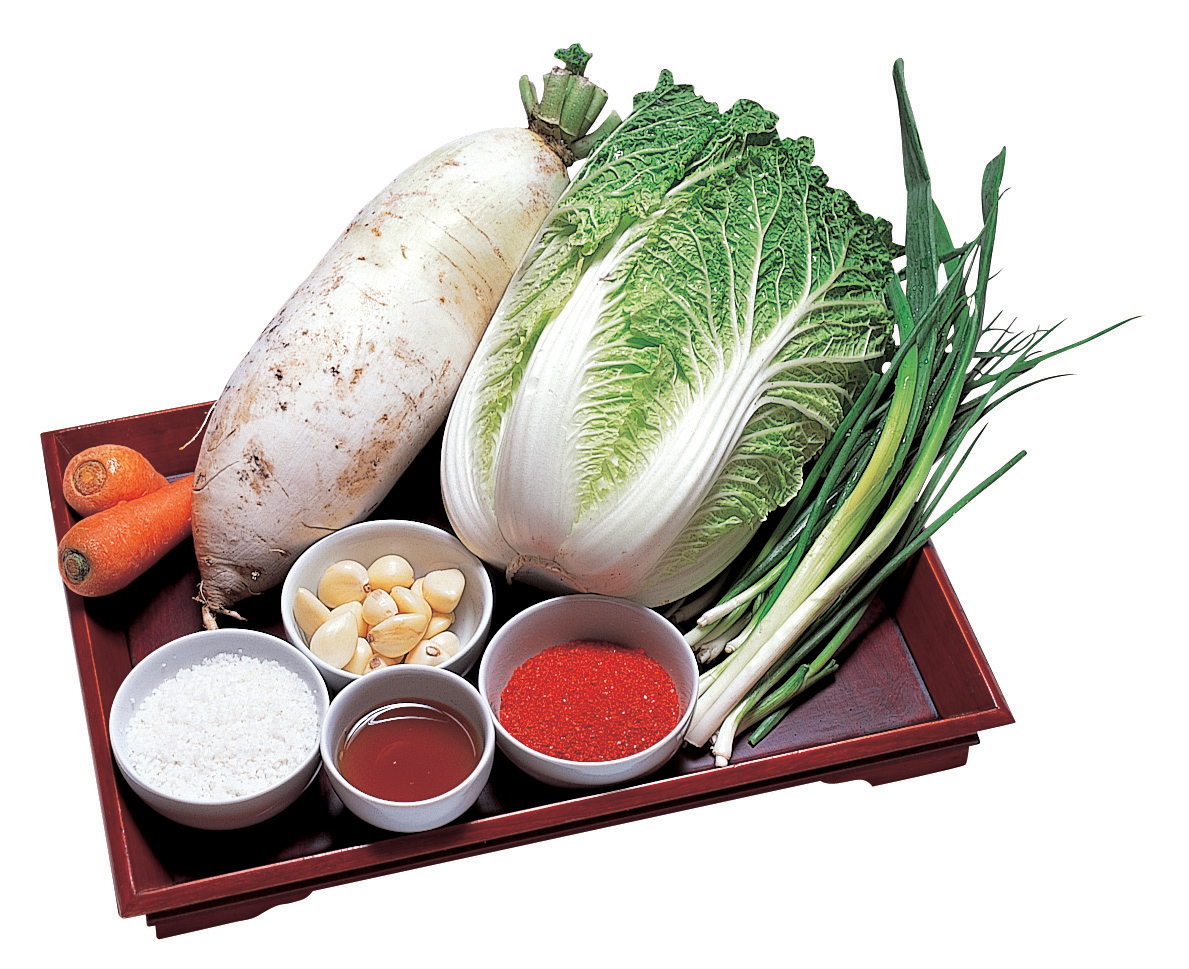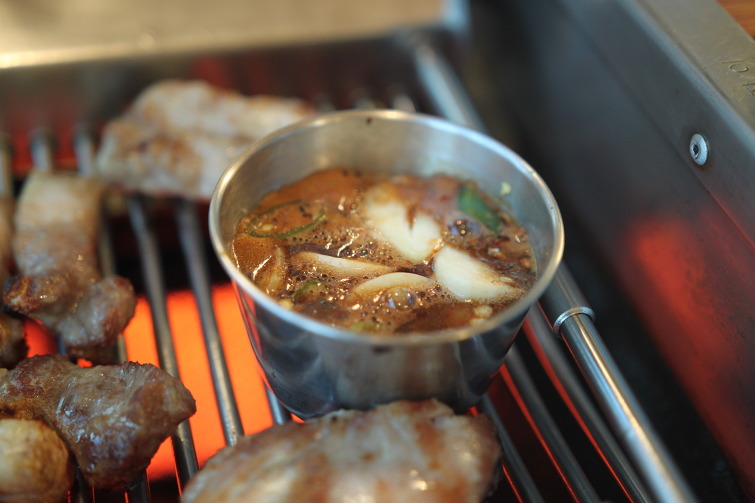|
Jogi-jeot
''Jogi-jeot'' () or salted yellow croaker is a variety of ''jeotgal'' (salted seafood), made with Larimichthys polyactis, yellow croakers. In Korean cuisine, ''jogi-jeot'' is widely used as ''banchan'' (side dish), as a condiment, or as an ingredient for kimchi. History Korean people have eaten yellow croakers for a very long time, as ''Shuowen Jiezi'', an early 2nd-century Chinese dictionary, reports that yellow croakers were caught in Lelang Commandery, Lelang, and that a Han dynasty, Han Commandery (China), commandery existed within the Korean peninsula. Preparation Fresh yellow croakers, with lustrous scales and a chubby belly, caught in May to June. are preferred. Croakers are washed and drained on ''sokuri'' (bamboo tray), then stuffed with Korean brining salt, coarse salt, and laid on a salt-lined ''onggi'' (earthenware jar). One layer of fish is followed by one layer of salt, and so on. When the jar is around 70% filled, split and sterilized bamboo stalks are laid ove ... [...More Info...] [...Related Items...] OR: [Wikipedia] [Google] [Baidu] |
Kimchi
Kimchi (; ) is a traditional Korean side dish (''banchan'') consisting of salted and fermented vegetables, most often napa cabbage or Korean radish. A wide selection of seasonings are used, including '' gochugaru'' (Korean chili powder), spring onions, garlic, ginger, and '' jeotgal'' (salted seafood). Kimchi is also used in a variety of soups and stews. Kimchi is a staple food in Korean cuisine and is eaten as a side dish with almost every Korean meal. There are hundreds of different types of kimchi made with different vegetables as the main ingredients. Examples of variants include ''baechu-kimchi'', ''kkakdugi'', '' chonggak-kimchi'', and '' oi-sobagi''. Traditionally, winter kimchi, called '' gimjang'', was stored in large earthenware fermentation vessels, called '' onggi'', in the ground to prevent freezing during the winter months and to keep it cool enough to slow down the fermentation process during summer months. The process of making kimchi was called gimjan ... [...More Info...] [...Related Items...] OR: [Wikipedia] [Google] [Baidu] |
Jeotgal
''Jeotgal'' () or ''jeot'' (), translated as salted seafood, is a category of salted preserved dishes made with seafood such as shrimps, oysters, clams, fish, and roe. Depending on the ingredients, ''jeotgal'' can range from flabby or solid pieces to clear, broth-like liquid. Solid ''jeotgal'' are usually eaten as ''banchan'' (side dishes). Liquid ''jeotgal'', called ''aekjeot'' () or fish sauce, is popularly used in kimchi seasoning, as well as in various soups and stews ('' guk'', '' jijimi'', '' jjigae''). As a condiment, jeotgal with smaller bits of solid ingredients such as '' saeu-jeot'' (shrimp ''jeotgal'') is commonly served as a dipping sauce with pork dishes ('' bossam'', '' jokbal'', '' samgyeopsal''), '' sundae'' (Korean sausage), '' hoe'' (raw fish), and a number of soups and stews. History Fermented foods were widely available in Three Kingdoms of Korea, as '' Sānguózhì'', a Jin Chinese historical text published in 289, mentions that the Goguryeo Koreans are ... [...More Info...] [...Related Items...] OR: [Wikipedia] [Google] [Baidu] |
Korea
Korea is a peninsular region in East Asia consisting of the Korean Peninsula, Jeju Island, and smaller islands. Since the end of World War II in 1945, it has been politically Division of Korea, divided at or near the 38th parallel north, 38th parallel between North Korea (Democratic People's Republic of Korea; DPRK) and South Korea (Republic of Korea; ROK). Both countries proclaimed independence in 1948, and the two countries fought the Korean War from 1950 to 1953. The region is bordered by China to the north and Russia to the northeast, across the Yalu River, Amnok (Yalu) and Tumen River, Duman (Tumen) rivers, and is separated from Japan to the southeast by the Korea Strait. Known human habitation of the Korean peninsula dates to 40,000 BC. The kingdom of Gojoseon, which according to tradition was founded in 2333 BC, fell to the Han dynasty in 108 BC. It was followed by the Three Kingdoms of Korea, Three Kingdoms period, in which Korea was divided into Goguryeo, Baekje, a ... [...More Info...] [...Related Items...] OR: [Wikipedia] [Google] [Baidu] |
Doopedia
''Doosan Encyclopedia'' () is a Korean-language encyclopedia published by Doosan Donga (). The encyclopedia is based on the ''Dong-A Color Encyclopedia'' (), which comprises 30 volumes and began to be published in 1982 by Dong-A Publishing (). Dong-A Publishing was merged into Doosan Donga, a subsidiary of Doosan Group, in February 1985. The ''Doosan Encyclopedia'' is a major encyclopedia in South Korea. Digital edition EnCyber The online version of the ''Doosan Encyclopedia'' was named EnCyber, which is a blend of two English words: ''Encyclopedia'' and ''Cyber''. The company has stated that, with the trademark, it aims to become a center of living knowledge. EnCyber provides free content to readers via South Korean portals such as Naver. Naver has risen to the top position in the search engine market of South Korea partially because of the popularity of EnCyber encyclopedia. When Naver exclusively contracted Doosan Doonga in 2003, the former paid multi billion won to the ... [...More Info...] [...Related Items...] OR: [Wikipedia] [Google] [Baidu] |
Banchan
''Banchan'' ( ; ; ) are small side dishes served along with cooked rice in Korean cuisine. ''Banchan'' are often set in the middle of the table to be shared. At the center of the table is the secondary main course, such as ''galbi'' or ''bulgogi'', and a shared pot of ''jjigae''. Bowls of cooked rice and ''guk'' (soup) are set individually. ''Banchan'' are served in small portions, meant to be finished at each meal and replenished during the meal if not enough. Usually, the more formal the meals are, the more ''banchan'' there will be. Jeolla Province is particularly famous for serving many different varieties of ''banchan'' in a single meal. The basic table setting for a meal called ''bansang'' usually consists of ''bap (food), bap'' (, cooked rice), ''guk'' or ''guk, tang'' (soup), ''gochujang'' or soy sauce, ''ganjang'', ''jjigae'', and ''kimchi''. According to the number of ''banchan'' added, the table setting is called ''3 cheop'' (), ''5 cheop'' (), ''7 cheop'' (), ''9 c ... [...More Info...] [...Related Items...] OR: [Wikipedia] [Google] [Baidu] |
Saeu-jeot
''Saeu-jeot'' * () is a variety of ''jeotgal'', salted and fermented food made with small shrimp in Korean cuisine. It is the most consumed ''jeotgal'' along with '' myeolchi-jeot'' (, salted anchovy ''jeot'') in South Korea. The name consists of the two Korean words ''saeu'' (, shrimp) and '' jeot''. ''Saeu-jeot'' is widely used throughout Korean cuisine but is mostly used as an ingredient in kimchi and dipping pastes. The shrimp used for making ''saeu-jeot'' are called ''jeot-saeu'' () and are smaller and have thinner shells than ordinary shrimp. The quality of ''saeu-jeot'' largely depends on the freshness of the shrimp. In warm weather, fishermen may immediately add salt for preliminary preservation. Types The types of ''saeu-jeot'' depend on the kind of shrimp used and when they are harvested. In spring ''Putjeot'' () is made with shrimp harvested from the end of the 1st month through the 4th month of the Korean calendar (lunisolar). It is called ''deddeugi jeot'' () or ... [...More Info...] [...Related Items...] OR: [Wikipedia] [Google] [Baidu] |
Myeongnan-jeot
Pollock roe, also pollack roe (also known as ''tarako'' in Japanese and ''myeongnan'' in Korean), is the roe of Alaska pollock (''Gadus chalcogrammus'') which, despite its name, is a species of cod. Salted pollock roe is a popular culinary ingredient in Japanese, Korean and Russian cuisines. Names The purely Korean name for ''pollock'', ''myeongtae'' can be written with Hanja (), which can be read as ''mentai'' in Japanese. But while the Japanese borrowed this name from Korean and called it ''mentaiko'', the term does not retain the original meaning of plain raw roe, but specifically refers the chili pepper-added cured roe, while salt-cured only types are called ''tarako''. Korean As aforementioned, Alaska pollock in Korean is ''myeongtae'' (), hence pollock roe is ''myeongnan'' (), a contracted form of the compound with +''ran'' or +''nan'' () meaning "egg (roe)". The salted roe dish is called ''myeongnan-jeot'' (), being considered a type of ''jeot'' () or ''jeotgal ... [...More Info...] [...Related Items...] OR: [Wikipedia] [Google] [Baidu] |
Myeolchi-jeot
''Myeolchi-jeot'' () or salted anchovies is a variety of ''jeotgal'' (salted seafood), made by salting and fermenting anchovies. * Along with ''saeu-jeot'' (salted shrimps), it is one of the most commonly consumed ''jeotgal'' in Korean cuisine. In mainland Korea, ''myeolchi-jeot'' is primarily used to make kimchi, while in Jeju Island, ''meljeot'' (; ''myeolchi-jeot'' in Jeju language) is also used as a dipping sauce. The Chuja Islands, located between South Jeolla and Jeju, are famous for producing the highest quality ''myeolchi-jeot''. Names and etymology ''Myeolchi-jeot'' () is a compound of ''myeolchi'' (), the Korean word for anchovy (''Engraulis japonicus''), and '' jeot'' (), the word meaning salted fermented seafood. ''Meljeot'' () is also a compound, consisting of ''mel'' (), the Jeju name for anchovy, and ''jeot''. The Jeju word ''mel'' is cognate with the first syllable ''myeol'' of the Korean word ''myeolchi'', whose second syllable ''-chi'' is a suffix attached ... [...More Info...] [...Related Items...] OR: [Wikipedia] [Google] [Baidu] |
Korean Overseas Information Service
The Korean Culture and Information Service (KOCIS; ) is an affiliated organization of the Ministry of Culture, Sports and Tourism of the South Korean government and runs 32 Korean cultural centers in 27 countries. The goal of the organization is to further enhance the image of Korea's national brand by promoting Korean heritage and arts through these cultural centers. It was announced in January 2024 that the service would shut down and become a part of the Ministry of Culture, Sports and Tourism. Main missions ¤ To upgrade the country's nation brand and to publicize government policies * Carrying out projects to boost the nation brand * Providing support for summit diplomacy by organizing cultural events and operating press centers during presidential visits abroad * Promoting Korea's key administrative priorities and major government policies around the world ¤ To promote the spread of Hallyu and to expand cultural exchanges * Operating overseas cultural centers and stre ... [...More Info...] [...Related Items...] OR: [Wikipedia] [Google] [Baidu] |
Onggi
''Onggi'' () is earthenware extensively used as tableware and storage containers in Korea. The term includes both ceramic glaze, unglazed earthenware, fired near 600 to 700°C, and pottery with a dark brown ceramic glaze, glaze fired at over 1100 °C. ''Onggi'' have been used continuously from prehistoric Korean states to the modern day; however, they primarily see use as traditional storage and ornaments today. The origin of ''onggi'' dates to around 4000 to 5000 BCE. The types of earthenware include patternless, Mumun pottery period, ''mumun'', and a red-and-black variety. The patternless earthenware is made with lumps of clay and fine sand. The predecessor of Goryeo celadon and Joseon white porcelain, the black/red earthenware excludes any sand in its creation process. The earthenware's color is determined by both the iron content of the clay and the method used to fire it. The modern onggi shape dates back from the Joseon era. History ''Ong'' () refers to a clay jar. Po ... [...More Info...] [...Related Items...] OR: [Wikipedia] [Google] [Baidu] |
Korean Brining Salt
Korean brining salt, also called Korean sea salt, is a variety of edible salt with a larger grain size compared to common kitchen salt. It is called ''gulgeun-sogeum'' (; "coarse salt") or ''wang-sogeum'' (; "king/queen salt") in Korean. The salt is used mainly for salting napa cabbages when making kimchi Kimchi (; ) is a traditional Korean side dish (''banchan'') consisting of salted and fermented vegetables, most often napa cabbage or Korean radish. A wide selection of seasonings are used, including '' gochugaru'' (Korean chili powder), .... Because it is minimally processed, there are microorganisms present in the salt, which serve to help develop flavours in fermented foods. References Salts Edible salt Korean cuisine {{Korea-cuisine-stub ... [...More Info...] [...Related Items...] OR: [Wikipedia] [Google] [Baidu] |



